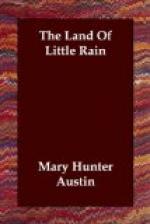The highest limit of conifers—in the middle Sierras, the white bark pine—is not along the water border. They come to it about the level of the heather, but they have no such affinity for dampness as the tamarack pines. Scarcely any bird-note breaks the stillness of the timber-line, but chipmunks inhabit here, as may be guessed by the gnawed ruddy cones of the pines, and lowering hours the woodchucks come down to the water. On a little spit of land running into Windy Lake we found one summer the evidence of a tragedy; a pair of sheep’s horns not fully grown caught in the crotch of a pine where the living sheep must have lodged them. The trunk of the tree had quite closed over them, and the skull bones crumbled away from the weathered horn cases. We hoped it was not too far out of the running of night prowlers to have put a speedy end to the long agony, but we could not be sure. I never liked the spit of Windy Lake again. It seems that all snow nourished plants count nothing so excellent in their kind as to be forehanded with their bloom, working secretly to that end under the high piled winters. The heathers begin by the lake borders, while little sodden drifts still shelter under their branches. I have seen the tiniest of them (Kalmia glauca) blooming, and with well-formed fruit, a foot away from a snowbank from which it could hardly have emerged within a week. Somehow the soul of the heather has entered into the blood of the English-speaking.
“And oh! is that heather?” they say; and the most indifferent ends by picking a sprig of it in a hushed, wondering way. One must suppose that the root of their respective races issued from the glacial borders at about the same epoch, and remember their origin.
Among the pines where the slope of the land allows it, the streams run into smooth, brown, trout-abounding rills across open flats that are in reality filled lake basins. These are the displaying grounds of the gentians—blue—blue—eye-blue, perhaps, virtuous and likable flowers. One is not surprised to learn that they have tonic properties. But if your meadow should be outside the forest reserve, and the sheep have been there, you will find little but the shorter, paler G. Newberryii, and in the matted sods of the little tongues of greenness that lick up among the pines along the watercourses, white, scentless, nearly stemless, alpine violets.
At about the nine thousand foot level and in the summer there will be hosts of rosy-winged dodecatheon, called shooting-stars, outlining the crystal runnels in the sod. Single flowers have often a two-inch spread of petal, and the full, twelve blossomed heads above the slender pedicels have the airy effect of wings.
It is about this level one looks to find the largest lakes with thick ranks of pines bearing down on them, often swamped in the summer floods and paying the inevitable penalty for such encroachment. Here in wet coves of the hills harbors that crowd of bloom that makes the wonder of the Sierra canons.




